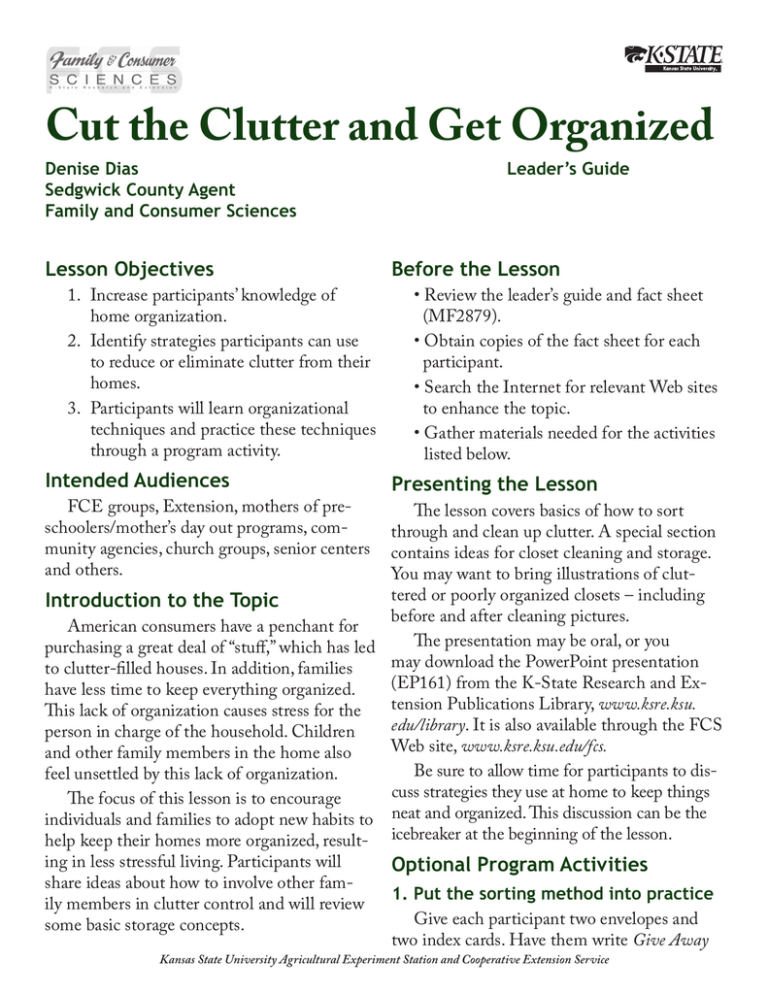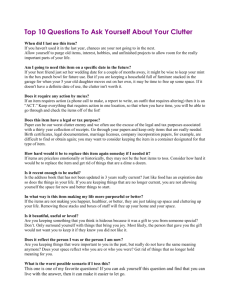
Cut the Clutter and Get Organized
Denise Dias
Sedgwick County Agent
Family and Consumer Sciences
Lesson Objectives
1.Increase participants’ knowledge of
home organization.
2.Identify strategies participants can use
to reduce or eliminate clutter from their
homes.
3.Participants will learn organizational
techniques and practice these techniques
through a program activity.
Intended Audiences
FCE groups, Extension, mothers of preschoolers/mother’s day out programs, community agencies, church groups, senior centers
and others.
Leader’s Guide
Before the Lesson
• Review the leader’s guide and fact sheet
(MF2879).
• Obtain copies of the fact sheet for each
participant.
• Search the Internet for relevant Web sites
to enhance the topic.
• Gather materials needed for the activities
listed below.
Presenting the Lesson
The lesson covers basics of how to sort
through and clean up clutter. A special section
contains ideas for closet cleaning and storage.
You may want to bring illustrations of cluttered or poorly organized closets – including
Introduction to the Topic
before and after cleaning pictures.
American consumers have a penchant for
The presentation may be oral, or you
purchasing a great deal of “stuff,” which has led
may download the PowerPoint presentation
to clutter-filled houses. In addition, families
(EP161) from the K-State Research and Exhave less time to keep everything organized.
tension Publications Library, www.ksre.ksu.
This lack of organization causes stress for the
edu/library. It is also available through the FCS
person in charge of the household. Children
Web site, www.ksre.ksu.edu/fcs.
and other family members in the home also
Be sure to allow time for participants to disfeel unsettled by this lack of organization.
cuss strategies they use at home to keep things
The focus of this lesson is to encourage
individuals and families to adopt new habits to neat and organized. This discussion can be the
help keep their homes more organized, result- icebreaker at the beginning of the lesson.
ing in less stressful living. Participants will
Optional Program Activities
share ideas about how to involve other fam1. Put the sorting method into practice
ily members in clutter control and will review
Give each participant two envelopes and
some basic storage concepts.
two index cards. Have them write Give Away
Kansas State University Agricultural Experiment Station and Cooperative Extension Service
and Store/File on the envelopes. Have them
write Put Away and Trash on the cards. One
envelope is for items to give away and one
envelope is for items or receipts to store or file.
The card labeled Put Away is for items to put
back into their purses or wallets after they have
sorted everything. The card labeled Trash is to
identify items that need to be thrown away.
Instruct attendees to empty their purses or
wallets and sort everything into the four piles.
Once they have completed that task, they can
return the Put Away pile to their purses. Next,
participants should place items in the Give
Away pile into its envelope to take home and
give away. The Store/File pile needs to go into
its envelope and be taken home and filed. The
trash pile goes into the trash can.
Ask participants how they felt before, during and after the activity. This same method of
sorting clutter can work in any room or closet
in their home.
contributions to clutter control. Make a weekly
schedule and rotate jobs so that no one does
the same job all the time.
Community Awareness Activities
1. Present the lesson to another group that
could benefit from this information.
2.Coordinate a recycling day, e-waste
recycling event or dumpster day in your
community or neighborhood.
3.Set up a display at a community event
that explains how to sort into categories
and turn a clutter-filled house into an
organized home.
Related Extension Publications
Organizing the Household, MF2254
Delegating, MF2255
Organizing Household Records, L801
(available at www.ksre.ksu.edu/library)
References
Kansas State Cooperative Extension Publication GT205, Mary E. Tucker, Extension Specialist,
Environmental Family Housing, 1986.
2. Make a job spinner
Use a paper plate or a circle of stiff paper.
Divide the circle as you would a pie. In each
section, write a household job to do. Make an
arrow out of stiff paper and attach it to the paper with a clasp fastener. Then spin the arrow
to determine your job.
Author
Denise Dias, Sedgwick County Extension Agent, FCS
Sedgwick County Extension Office
7001 W 21st Street N
Wichita, KS 67205
316-660-0100
ddias@ksu.edu
3. Make a job jar
Write all jobs and chores on slips of paper,
and place the slips in a can or jar. When its time
to assign chores, every family member chooses a
slip of paper from the jar until all slips are gone.
These are the chores for everyone to do for the
next week, month, etc. One jar could be for
routine or daily tasks (such as feeding the pets,
washing dishes and taking out the trash) and
one jar could be for occasional tasks (washing
windows and sweeping the porch).
4. Make a chart or bulletin board
Use it for family members to record their
Reviewers
Shirley Niemeyer, Ph.D., Professor
Extension Specialist/Research,
Housing and Environment
Room 205 HE Bldg. East Campus
University of Nebraska-Lincoln
Lincoln, NE 68583-0804
Jan McMahon, Sedgwick County
Extension Agent, FCS,
EFNEP (Expanded Food and Nutrition
Education Program)
2
Cut the Clutter Evaluation
Date of Program: _________________________
Program County: _________________________
Instructor: _______________________________
1. Because of my participation in Cut the Clutter and Get Organized, I learned something new. Circle either yes or no.
2. If yes, what did you learn?
3. Because of your participation in this program, do you plan to take any action or change anything in your life?
Circle yes or no.
4. If yes, what will you change?
5. For the following questions, please place a check in the appropriate box.
Definitely More false
false
than true
Because of this program, I have more positive
feelings about this topic.
Overall, I rate this program as excellent.
Overall, I rate this instructor an excellent
teacher.
3
In between More true
than false
Definitely
true
Brand names appearing in this publication are for product identification purposes only. No endorsement is intended,
nor is criticism implied of similar products not mentioned.
Publications from Kansas State University are available on the World Wide Web at: www.ksre.ksu.edu
Contents of this publication may be freely reproduced for educational purposes. All other rights reserved. In each case, credit
Denise Dias, Cut the Clutter and Get Organized, Leader’s Guide, Kansas State University, July 2009
Kansas State University Agricultural Experiment Station and Cooperative Extension Service
MF2880
July 2009
K-State Research and Extension is an equal opportunity provider and employer. Issued in furtherance of Cooperative Extension Work, Acts of May 8 and June 30, 1914, as
amended. Kansas State University, County Extension Councils, Extension Districts, and United States Department of Agriculture Cooperating, Fred A. Cholick, Director.



